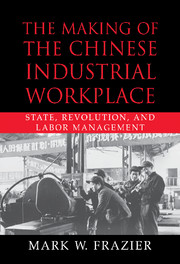Book contents
- Frontmatter
- Contents
- List of Tables
- List of Acronyms
- Preface
- 1 Introduction
- 2 Labor Management and Its Opponents, 1927–1937
- 3 Welfare and Wages in Wartime
- 4 Takeover Policies and Labor Politics, 1949–1952
- 5 Adjusting to the Command Economy
- 6 Enterprise Perspectives on the Command Economy
- 7 The Rise of “Party Committee Factories”
- 8 Conclusion
- Archives Consulted
- Bibliography
- Index
4 - Takeover Policies and Labor Politics, 1949–1952
Published online by Cambridge University Press: 15 December 2009
- Frontmatter
- Contents
- List of Tables
- List of Acronyms
- Preface
- 1 Introduction
- 2 Labor Management and Its Opponents, 1927–1937
- 3 Welfare and Wages in Wartime
- 4 Takeover Policies and Labor Politics, 1949–1952
- 5 Adjusting to the Command Economy
- 6 Enterprise Perspectives on the Command Economy
- 7 The Rise of “Party Committee Factories”
- 8 Conclusion
- Archives Consulted
- Bibliography
- Index
Summary
As units of the PLA advanced into urban areas of north China in early 1949, then into the cities of east, central, and south China during the remainder of that year, Communist Party officials faced a new and in many ways unfamiliar set of challenges. CCP cadres had gained some limited exposure to the complexities of urban government and industrial policy during their takeover of cities in Northeast China in 1948. Stabilizing labor relations and maintaining industrial production had been one of the critical, if not easily grasped, lessons of the 1948 urban takeovers. Yet the stakes were immensely higher in 1949, as Communist forces entered China's major commercial and industrial centers of Beijing, Tianjin, Shanghai, and Guangzhou. Industrial production and commercial activity in many of these cities had all but collapsed, but both had to be restored quickly and carefully, for political as well as national security purposes. The consequences of mismanaging the urban economy through mistaken monetary, fiscal, and industrial policies were ever present. It had only taken a few years between 1945 and 1948 for the Nationalist regime, with its much broader knowledge base of administrators and technocrats, to drive urban areas to financial ruin.
CCP officials therefore relied, however reluctantly, on the existing pool of expertise that remained from Nationalist government personnel. At the factory level, this meant a policy of retaining enterprise managers and technicians, many of whom were Nationalist “officials” simply by virtue of the fact that their enterprises were state-owned.
- Type
- Chapter
- Information
- The Making of the Chinese Industrial WorkplaceState, Revolution, and Labor Management, pp. 92 - 131Publisher: Cambridge University PressPrint publication year: 2002



